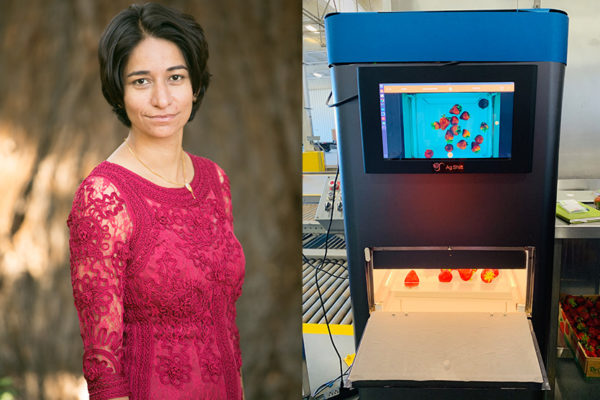Technology Meets the Eye
Miku Jha, MBA ’11, is founder and CEO of AgShift, a company that applies deep learning and machine vision technologies to examine produce and other food commodities.

Miku Jha, MBA ’11, founder and CEO of AgShift, and strawberries in AgShift’s Hydra analyzer getting inspected and graded to assess their quality
More than 30 percent of the food supply goes to waste in the United States — much of it at the consumer level, to be sure. But a lot of perfectly edible food never makes it to the supermarket because of subjective and inconsistent quality assessment at the inspection level, creating a domino effect that costs organizations billions in lost revenues.
Software engineer and entrepreneur Miku Jha wondered why food quality assessment could not be made more efficient — more data-driven, more objective.
“Why can’t we have a self-grading strawberry?” she asked a produce quality veteran.
“If you can do it,” he replied, “I can run my business 100 times better.”
Jha’s idea behind AgShift — the company that built the world’s first autonomous food inspection system — is to apply deep learning and machine vision technologies to examine produce and other food commodities using the quality standards of the USDA or internal company measures. Using AgShift’s Hydra analyzer, inspectors can take an image of the commodity samples to be inspected and upload it to the cloud for processing, where AgShift’s AI models will virtually inspect the image for bruising, mold, or a host of other grading parameters to assess its quality.
Founded in 2016, Sunnyvale, California-based AgShift is initially focused on three categories: fresh produce (beginning with strawberries), edible nuts (commencing with cashews and almonds), and fresh seafood (starting with shrimp). “Our customers are typically the organizations in food supply chains,” such as Driscoll’s, the world’s largest berry company, explains Jha, who has raised more than $5 million in seed funding for AgShift.
“There is a lot of education that needs to happen to bridge this gap between tech and food,” she adds. “The fact that we are able to do our part in reducing food waste helps me show up and tackle challenges head-on, every day. You could have the coolest technology, but if you’re not solving a business problem, you’re not helping anything.”
